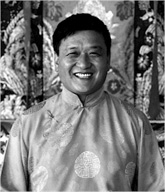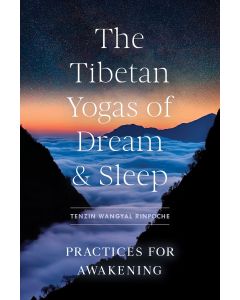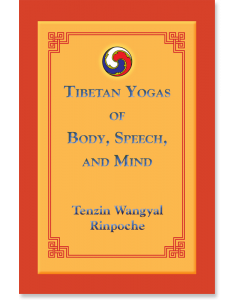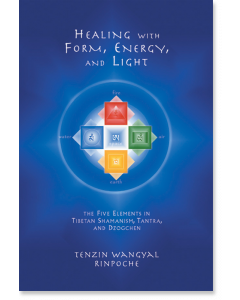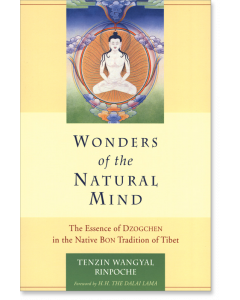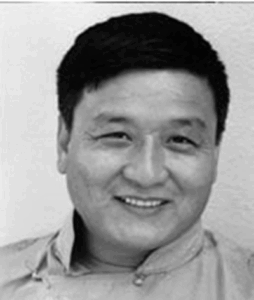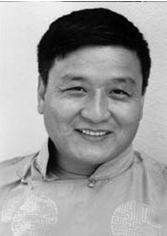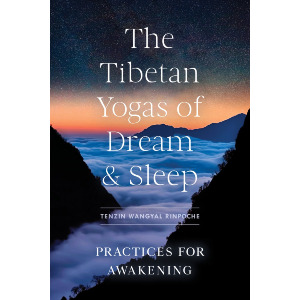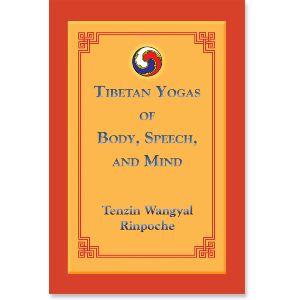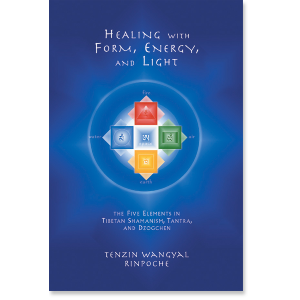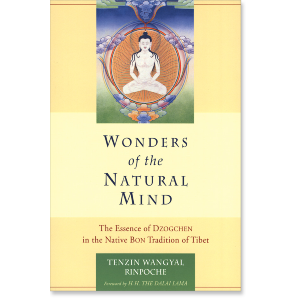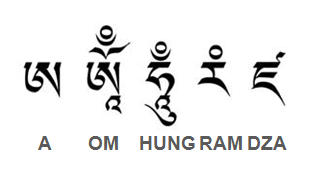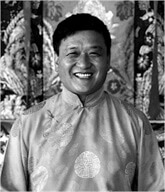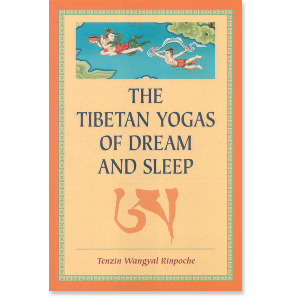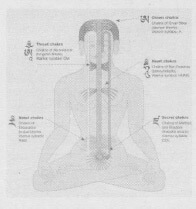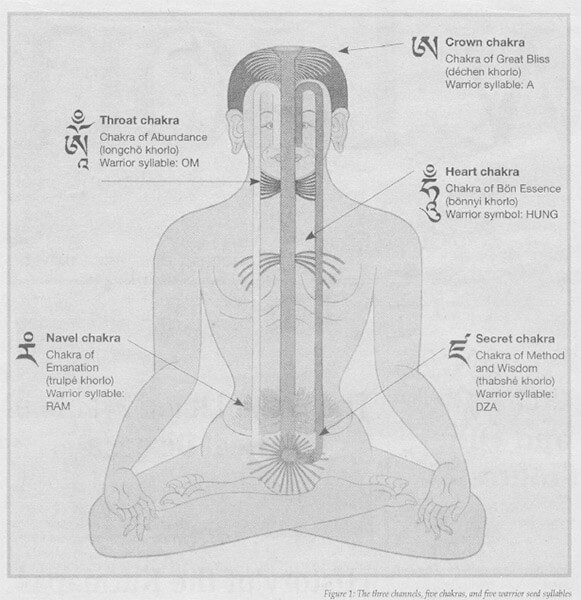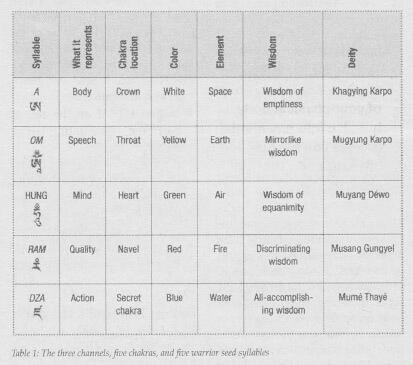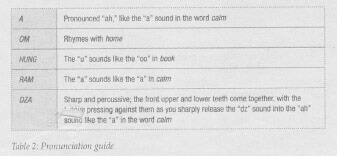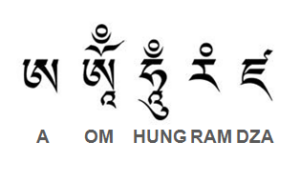TENZIN WANGYAL RINPOCHE: Yes, there are different levels of sound practice. Ancient Tibetan yogis who lived in the wilderness far from medical care used sound and other yogic techniques to maintain their health, for example.
We know that in acupuncture, when a needle is placed in a part of the body, it sends a vibration or message to another part, bringing balance and healing. In a similar way, the vibration of sound as it reverberates on the lips, in the head, and in the chest can affect the body and organs in a very healing way. As the health is affected, so are the mind and emotions. If you chant the syllable RAM for the fire element, for example, that vibration opens certain channels and chakras, affecting in turn certain organs, and brings a particular experience of higher consciousness.
Q: How does one know what sounds to use?
TWR: This is a very ancient system and is described in a number of Tibetan texts. I'm teaching primarily from the Bon Mother Tantra (Ma Gyud). The Mother Tantra describes specific sound practices to treat physical ailments such as headaches, chest pain, and other problems.
The right sounds create balance between the five elements of earth, water, fire, air, and space. These elements, present in nature, are also present in each one of us. Our own particular balance of the elements strongly affects our mental and physical states-so maintaining this balance is essential to good health. There are practices of chanting certain sounds, certain syllables, which activate or pacify each of the elements. These have a subtle but potent effect on our organs, and on our mental and spiritual states.
Q: Please say more about how we should view sound from the point of view of spiritual practice.
TWR: As a practitioner, you can look at sound in three different ways. First, on the ordinary level, one should become aware of one's use of words and how these choices affect oneself and others. Secondly, on an energetic level, one may connect with the sounds themselves. These seed sounds contain elemental qualities that vibrate different parts of the body and different chakras, as I mentioned before. As our chakras are affected in this way, a higher vibration may be activated. Thirdly, and ultimately, the role of sound for the practitioner must be for self-realization.
Q: With the first of these, are you talking about "virtuous speech?"
TWR: Yes, partly. In the traditional teachings, four of the ten "nonvirtuous actions" are connected with speech: lying, slander, harsh words, and meaningless chatter. But where do these arise? It says in the Dzogchen teachings that when the sound and innate awareness merge, it produces speech-enlightened speech and samsaric speech. If the realization of that union of sound and innate awareness (rigpa) is present, then speech is naturally very pure.
Q: Most of us are not at that level of awareness.
TWR: When someone is completely awakened, speech comes out spontaneously in response to circumstances, without a plan and without concept. For someone who is very mindful, having conscious awareness but without this complete awakening, speech is still very pure. Every word has meaning and purpose. It is not idle and certainly not hurtful. Then, if we are not able to achieve this level of mindfulness, discipline alone is a help, with rules guiding how we use our speech.
The main thing is that when there is a lack of awareness, when our inner space is not clear, wrong speech arises. If we observe ourselves, we see this clearly. When I am upset, it is easy for harsh or foolish words to come out if, at that moment, I also lack awareness. I cannot always change the outer circumstances that are upsetting me. But when I have awareness, I can change my inner space.
Q: It sounds like the relationship between sound and mind states goes both ways. Yogis use sound to express certain mind states or experiences. And, as practitioners, we can use these sounds to induce certain physical and mental states. Is this true?
TWR: Sound is one manifestation of certain qualities and essence, so there is a direct relationship there. This means that if you work with sound, you can connect with those qualities and essence. Also if you connect with certain enlightened qualities, you can express them through sound.
Using sound in spiritual practice is not unlike using your body in spiritual practice. Your body is not you in an ultimate sense, but it is an aspect of you. Through your body you can develop. Through your body you can also be sick. Speech is also like this. Physical sound originates directly in the physical body. The quality, energy, and vibration of sound relate to the pranic level. The essence of sound is the nature of mind, one's very being. But does working with one level work with all? That has to do with your level of awakening. You might be aware of the gross sound, but the nature of the sound, the deep quality of the sound can be obscured. When you say the sacred syllable A, it is easy for the ear to hear the gross sound, but to recognize the deeper energetic vibration, you need greater sensitivity.
Q: Mantras, strings of sacred syllables, are very important in the spiritual practices of Tibet, India, and other parts of Asia. Can you say anything about the origins of mantras?
TWR: Historically, there were enlightened individuals who themselves awakened in those sounds, who realized the power of those mantras, and saw how they could benefit sentient beings. They then developed whole cycles of teachings and practices related to those mantras. In essence, though, it is much deeper. Energetically, each individual sound is produced by its own root, which is beyond time and space.
Q: Rinpoche, in the generation stage of classic tantric sadhanas, sounds, in this case seed syllables, are used in a very specific way. There is space. Then the seed syllable arises, and from that the deity. Can you say more about this very special use of sacred sound?
TWR: One can look at this in different ways.
In the Bon Mother Tantra there is a beautiful commentary called "The Birthless Sphere of Light." It says, "From the body of the unborn essence arises the sphere of light, and from that sphere of light arises wisdom. From the wisdom arises the seed syllable and from the seed syllable arises the complete mandala, the deity and the retinue."
Another way of looking at it is like this. Radios and televisions work by picking up a certain frequency, right? There is space and in that space there is a frequency. In order to perceive that frequency you need a good receiver and a good color screen. In terms of the classic tantric sadhanas, it is not as if one letter just pops up in space. It is not like that. Sound and space are infinite. This subtle vibration that we humans, accustomed to sounds and images, perceive as the sacred seed syllable or as the deity exists in that space and appears in compassionate response to a need.
Q: My own experience with these practices is that, at first, I work hard to visualize something, to create a picture in my mind. But as my practice develops over time, I have a sense of connecting with something much greater than my mind could create. Is this what you are saying?
TWR: Yes. Basically one is tuning into something that already exists rather than making something up. We are trying to be in the right frequency ourselves so we can connect with what's there. Sometimes we are able to connect; sometimes we are not able to connect. Through practice, through cultivating certain qualities, certain kinds of stability, the ability to connect increases. It depends on the level of the practitioner. The beginner may be more like an old, blurry black and white TV while the advanced yogi perceives the high quality digital image. The frequency they perceive is the same-spontaneously existing in space and arising with wisdom and compassion.
It is not necessary to see this only in esoteric terms. We use this same process in generating any quality. For example, a person is sad and needs to develop joy. Joy may be present and perfect in its essence but is hidden in experience. How do we bring it into expression? First we try to connect with the seed of joy, like a small flame inside. Once that seed is discovered, we cultivate and develop it. Gradually, then, we act it out. Then it becomes complete, at least for human beings like us who have body, speech and mind. Samantabhadra probably doesn't need to express it in order to feel complete, but we humans do! The "Practice of the Five Warrior Syllables" is helpful for developing such positive qualities. In this modern time, with the many stresses we face, we need to develop ways to balance and harmonize our energy. This is important of course for health. But, most important, it can support our spiritual growth.
This interview with Tenzin Wangyal Rinpoche was conducted and edited by Helen Gatling-Austin.

